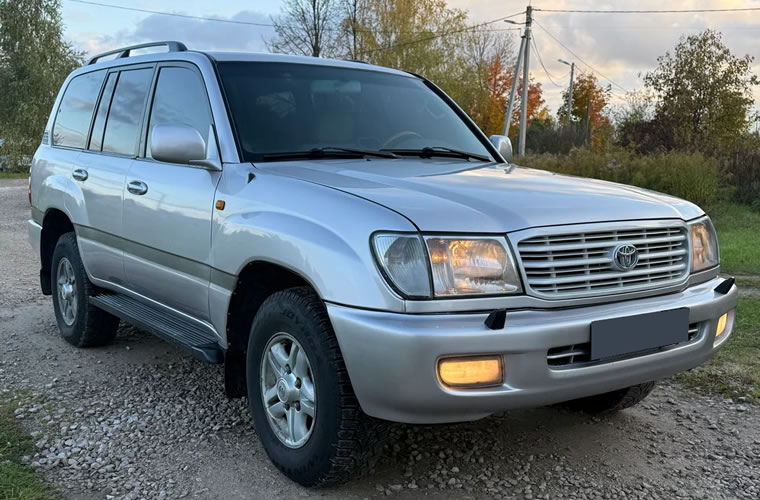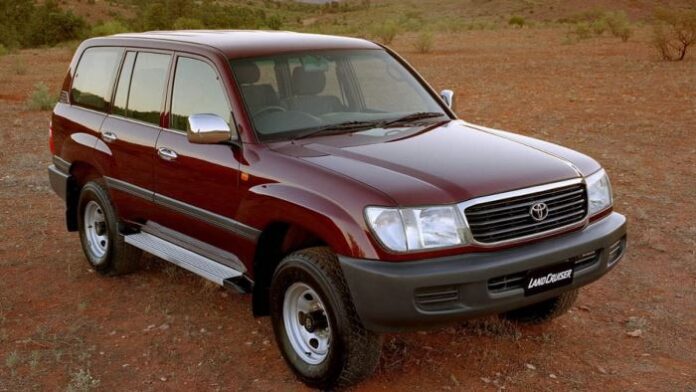1.0 Introduction
This document provides a comprehensive analysis of the Toyota Land Cruiser 100 Series (J100 chassis), a full-size Sport Utility Vehicle (SUV) manufactured from 1998 to 2007. The purpose of this report is to detail the vehicle’s architectural configuration, primary technical characteristics, its position within the contemporary market landscape, and fundamental protocols for its maintenance and repair. The Land Cruiser 100 Series was engineered to balance refined on-road comfort with formidable off-road capability, succeeding the highly regarded 80 Series and establishing a new benchmark for luxury in the segment.

2.0 Technical Architecture and Specifications
The Land Cruiser 100 Series represented a significant evolution in the model’s lineage, incorporating advanced technologies while retaining its core competency of exceptional durability and all-terrain performance.
- 2.1 Platform and Chassis: The vehicle utilized a body-on-frame construction, employing a robust box-section ladder frame designed for high torsional rigidity. A notable revision for certain markets was the introduction of an independent front suspension (IFS) system, replacing the solid front axle of its predecessor to improve on-road manners.
- 2.2 Powertrain Systems: Two primary engine options were available globally.
- The 4.7-liter 2UZ-FE V8 gasoline engine, featuring an aluminum block and double overhead camshafts (DOHC), produced approximately 235 horsepower and 320 lb-ft of torque. This engine incorporated Variable Valve Timing with intelligence (VVT-i) in later models.
- The 4.2-liter 1HD-FTE inline-six turbo-diesel engine, renowned for its reliability and high torque output.
- 2.3 Drivetrain and Suspension: Permanent four-wheel drive was standard, utilizing a Torsen limited-slip center differential. The vehicle was equipped with an advanced electronic system, the Active TRAC Stability Control, and the optional Hydraulic Height Control (AHC) and Adaptive Variable Suspension (AVS) systems. The braking system featured four-piston front calipers for improved stopping power.
- 2.4 Key Dimensions and Capacities:
- Seating Capacity: Standard configuration for 5 passengers, with optional 7-seat arrangement.
- Curb Weight: Ranged from approximately 2,300 to 2,600 kg, dependent on configuration.
- Fuel Tank Capacity: 96 liters (main) + 45 liters (sub), for a total of 141 liters in specific models.
3.0 Competitive Landscape Analysis
During its production cycle, the Land Cruiser 100 Series competed in the premium full-size SUV segment. Its primary competitors included the following models:
- The Range Rover (L322 Generation), which offered superior on-road refinement and luxury appeal but historically demonstrated lower reliability metrics.
- The Nissan Patrol (Y61 Series), which maintained a solid front and rear axle configuration, appealing to traditional off-road purists but offering a less refined on-road experience.
- The Lexus LX 470, a corporate sibling sharing the J100 platform and powertrain, positioned as a more luxurious alternative with minor cosmetic and feature differences.
- The Mercedes-Benz G-Class (W463), which held a unique, iconic status and superior brand prestige but at a significantly higher purchase cost.
The Land Cruiser’s competitive advantage was rooted in its demonstrably superior long-term reliability, lower total cost of ownership, and unparalleled resale value, establishing it as the preferred asset for demanding applications in both commercial and private sectors.
4.0 Maintenance and Repair Protocol Overview
Adherence to prescribed maintenance schedules is imperative for ensuring the vehicle’s longevity, safety, and performance. The following protocols are derived from the manufacturer’s official documentation.
- 4.1 Scheduled Servicing:
- Engine oil and filter changes are required at intervals not exceeding 10,000 kilometers or 6 months, utilizing fully synthetic oil of the correct specification.
- Inspection and replacement of the timing belt on the 2UZ-FE engine is a critical service item, mandated every 150,000 kilometers or 90 months. Neglect of this procedure carries a high risk of catastrophic engine failure.
- The engine cooling system requires periodic flushing and coolant replacement to prevent overheating, a known vulnerability of the V8 engine.
- 4.2 Drivetrain and Chassis Maintenance:
- Differential and transfer case fluids must be replaced at intervals specified in the service schedule, particularly if the vehicle is frequently operated in demanding off-highway conditions.
- The front brake pads and discs are subject to high wear due to vehicle mass and require regular inspection.
- The Hydraulic Height Control (AHC) system, if equipped, necessitates specialized fluid and requires bleeding procedures performed by trained technicians using appropriate diagnostic equipment.
- 4.3 Common Service Advisories:
- Heated Oxygen (O2) sensors are known to degrade over time, triggering check engine warnings and impacting fuel economy.
- The multi-disc CD changers, a common period feature, are prone to mechanical failure.
- Corrosion of the secondary Air Injection piping, used for emissions control during cold starts, is a frequent point of failure in regions that use road salt.
5.0 Conclusion
The Toyota Land Cruiser 100 Series is a vehicle of significant engineering merit, successfully integrating enhanced comfort and technological sophistication with the model’s foundational principles of robustness and all-terrain capability. Its market position was defined by its exceptional durability and asset retention, rather than leading in any single metric of luxury or performance. For current owners and prospective purchasers, a disciplined and proactive approach to maintenance, with particular emphasis on critical engine and driveline components, is essential for the preservation of the vehicle’s operational integrity and long-term investment value.








